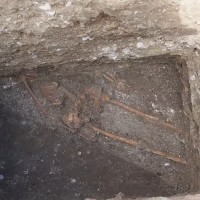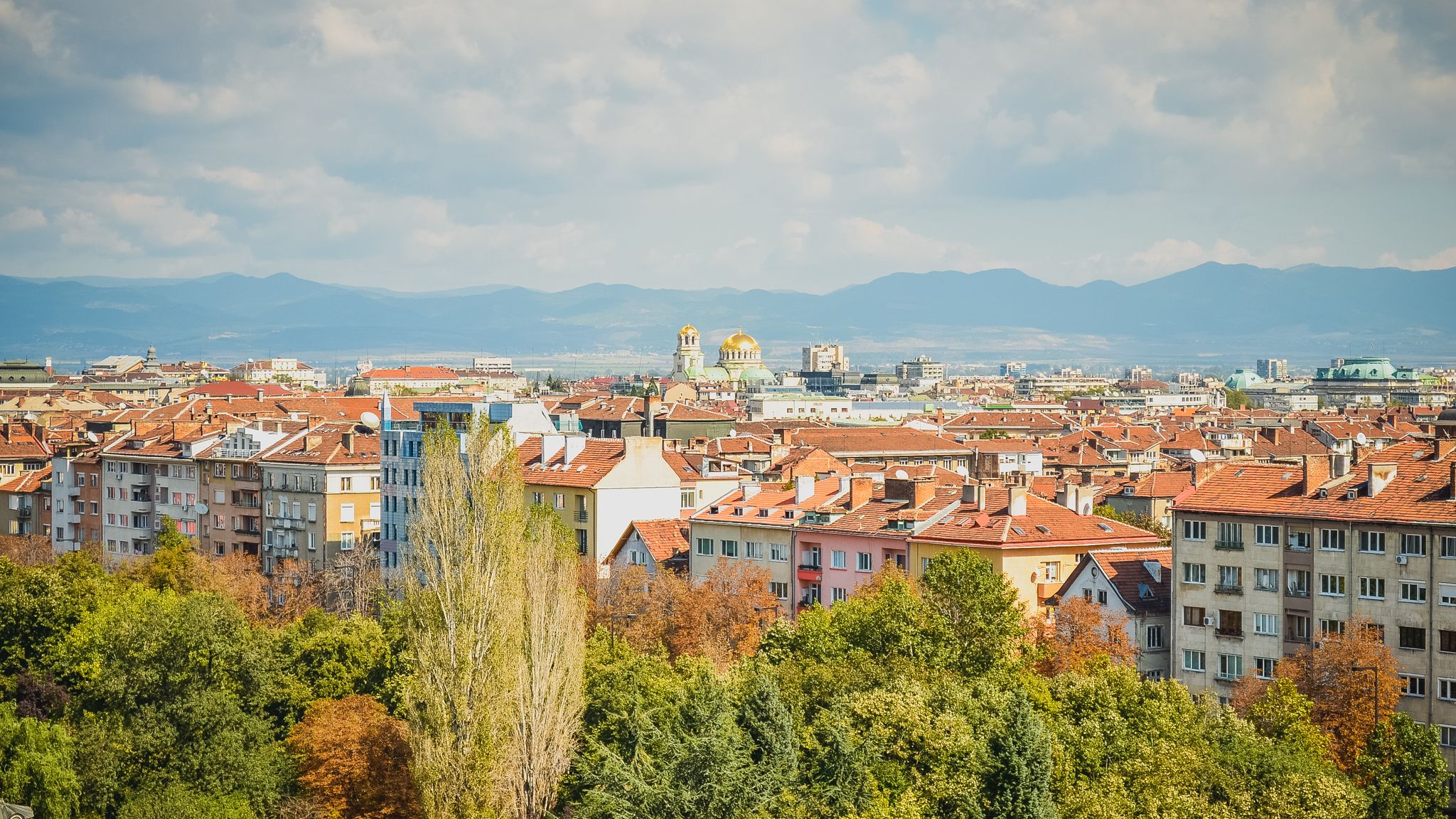
Bulgarian Archaeologists Find Stone Inscription, Red Marble Pillar in Bishop’s Basilica in Roman and Byzantine Fortress Zaldapa

A stone inscription in Ancient Greek has been found during the excavations of the bishop’s basilica in the Late Roman and Early Byzantine city of Zaldapa, Krushari Municipality, Dobrich District, in Northeast Bulgaria. Photo: Standart daily
A stone inscription in Greek has been discovered by the archaeologists excavating the ruins of a Christian bishop’s basilica in the Roman and Byzantine fortress of Zaldapa, which is located in Krushari Municipality, Dobrich District, in Northeast Bulgaria.
According to the initial reading of the stone inscription made by archaeologist Yoto Yotov from the Dobrich Regional Museum of History, it expresses gratitude for God, and was probably a gravestone inscription placed in the foundations of the bishop’s basilica in Zaldapa, reports local news site Top Novini Dobrich.
In addition to the inscription in Greek, which is yet to be examined further and dated, the archaeologists from the Dobrich Regional Museum of History have also found a stone with a depiction of a flower which they believe was used for decoration.
The archaeologists, who have been working on the excavations of the bishop’s basilica in the Ancient Roman and Early Byzantine city of Zaldapa since 2014, have also another pillar of red marble, the so called Breccia Carolina, after one red marble column was found in the first full-fledged archaeological excavations of Zaldapa in 2014.
“Red columns are typical of the temples where emperors were crowned. What we have found so far makes us hope that we will also find green marble pillars which were used as decorations for the throne of the patriarch or, in our case, the bishop. We also think we might find the home of the senior clergyman,” says Kostadin Kostadinov, Director of the Dobrich Regional Museum of History, as cited by the Bulgarian daily Standart.
The city of Zaldapa was the birthplace of Byzantine general Vitalian (d. 520) who in 513 AD led a rebellion against Byzantine Emperor Anastasius which grew into a 5-year civil war.
Because of the discovery of the red marble pillars the Dobrich archaeologists believe the bishop’s basilica in Zaldapa might have been the place where the rebellious general Vatialian might have been crowned Emperor of the Eastern Roman (Byzantine) Empire.
It is precisely Vitalian’s attempt to become the Emperor of Byzantium that explains the presence of red marble pillars in Zaldapa, the archaeologists reckon.
Another interesting discovery is a bronze spoon which is believed to have been used for Holy Communion during the Late Antiquity.

The ruins of the Ancient Roman and Early Byzantine city of Zaldapa in Northeast Bulgaria. Photo: Top Novini Dobrich
Even though the Roman and Byzantine city has been badly affected by decades of looting by treasure hunters, the archaeologists from the Dobrich Regional Museum of History and the local authorities in Krushari Municipality are hoping to be able to develop Zaldapa as a major destination for cultural and historical tourism, an effort that will run parallel to the further excavations and study of the site together with archaeologists from France and Canada who already took part in the 2015 summer digs there.
The project for turning the Roman and Byzantine city of Zaldapa into a cultural tourism site is expected to be completed by October 2015; the Dobrich Museum and Krushari Municipality plan to apply for funding from the EU Rural Development Program; they also think Zaldapa may be combined in a joint tourist route with the Tropaeum Traiani, a monument built by Roman Emperor Trajan in 109 AD, which was restored in 1977, and which is located just several kilometers to the north of Zaldapa in neighboring Romania.
In addition to that, the Dobrich archaeologists hope that their cooperation with French and Canadian archaeologists will make Zaldapa an international training place for young archaeologists as of 2017.

The newly found inscription in Zaldapa is in Greek, and was probably a gravestone built into the foundations of the bishop’s basilica. Photo: Top Novini Dobrich
The Ancient Thracian, Ancient Roman, and Early Byzantine fortress Zaldapa located between the towns of Abrit and Dobrin, Dobrich District, Northeast Bulgaria, is said to be the largest fortified settlement in the geographic region of Dobrudzha (covering much of Northeast Bulgaria). Because of the name of the town of Abrit, for a long time, in the 19th and the first half of the 20th century, the Bulgarian archaeologists and historians thought the Zaldapa Fortress was in fact the legendary ancient city of Abritus – until the ruins of Abritus were discovered some 100 km to the southwest, near the city of Razgrad, in 1953.
Zaldapa (meaning “yellow water”) was originally an Ancient Thracian settlement founded in the 8th century BC. It is located on a large peninsula-shaped plateau with a length of 1.2 km and a width of 500 meters (totaling 0.6 square km). Archaeological observations indicate that Zaldapa was densely built-up and populated. The entire settlement covered an area of 35 hectares (app. 86 acres). Zaldapa’s fortress wall appears homogenous meaning it was probably constructed in a single campaign, without major reconstructions in subsequent periods. It has a lot of straight sections as well as a total of 32 fortress towers of various shape and size, as well as 3 main and 2 smaller gates. The type of the fortification indicates that it was built in the Late Antiquity, i.e. the Late Roman period, most probably in the second half of the 4th century AD.
Zaldapa was first explored in 1906-1910 by Czech-Bulgarian archaeologist Karel Skorpil, one of the founders of modern-day Bulgarian archaeology. Later archaeological exploration has been reduced to terrain observations. Between World War I and World War II, when the region of Southern Dobrudzha was part of Romania, Zaldapa was also researched by Romanian archaeologists any findings they might have had have not made it to the Bulgarian archaeologists. Proper archaeological excavations at Zaldapa were carried out for the first time in 2014 by archaeologists from the Silistra Regional Museum of History, the Dobrich Regional Museum of History, and the Varna Museum of Archaeology (Varna Regional Museum of History). Unfortunately, since the end of the 19th century the Ancient Thracian and Roman city of Zaldapa has been targeted by looters and treasure hunters. All archaeological explorations there to date have studied part of the fortifications, a Roman civic basilica, an Early Christian basilica, and a huge water reservoir.
The so called Roman civic basilica was explored by Czech-Bulgarian archaeologist Karel Skorpil in the first decade of the 20th century. It is located in the center of Zaldapa, and has dimensions of 101 by 18 meters. Its walls are constructed according to the Roman style opus implectum, and its floor is tiled with bricks. According to Bulgarian archaeologist Assoc. Prof. Sergey Torbatov from the National Institute and Museum of Archaeology, the basilica was probably an entire architectural complex consisting of two basilicas with a common entryway; it was a Roman public building with judicial and commercial functions.
In 1906, Karel Skorpil also explored an Early Christian church, a three-nave, one-apse basilica with dimensions 27 meters by 16 meters, situation in the east-west direction. It was built in the same style as the fortress wall and the civic basilica, most probably at the end of the 5th and the beginning of the 6th century AD, during the reign of Byzantine Emperor Anastasius I Dicorus (r. 491-518 AD). A bishop’s basilica was discovered at Zaldapa in the first regular excavations in 2014 by archaeologists from the Silistra Regional Museum of History, the Dobrich Regional Museum of History, and the Varna Museum of Archaeology (Varna Regional Museum of History) led by Prof. Georgi Atanasov and Prof. Valeri Yotov.
The water reservoir of the Zaldapa fortress was discovered in 1949 by Bulgarian archaeologist M. Mirchev. It is located northwest of the fortress itself. It was a rather complex engineering facility consisting of two spaces. The water reservoir was connected with the fortress with a secret passage, a rock tunnel which is 3 meters wide and 3 meters tall. The Bulgarian archaeologists believed that because of its vulnerable location outside the fortress wall and the secret passage, it was covered with earth immediately after its construction to hide it from the enemy forces. The water reservoir was likely constructed in the second quarter of the 4th century AD together with other Late Roman urban infrastructure in the city of Zaldapa.
According to the works of 7th century AD Byzantine chronicler John of Antioch, the city of Zaldapa was the birthplace of Byzantine general Vitalian (d. 520) who led a rebellion against Byzantine Emperor Anastasius which grew into a 5-year civil war. The city of Zaldapa is also found in the list of fortifications renovated during the reign of Byzantine Emperor Justinian I the Great (r. 527-565 AD) where it was also mentioned as the seat of a Christian bishop under the diocese of the metropolitan in Tomis (today’s Constanta in Romania). The fortress of Zaldapa was in use by the Later Roman Empire and Early Byzantine Empire (i.e. the Eastern Roman Empire) for about 250 years – between the second half of the 4th century AD, and the end of the 6th century AD when the city of Zaldapa was depopulated as a result of the great barbarian invasion of the Avars in 585 AD.





















